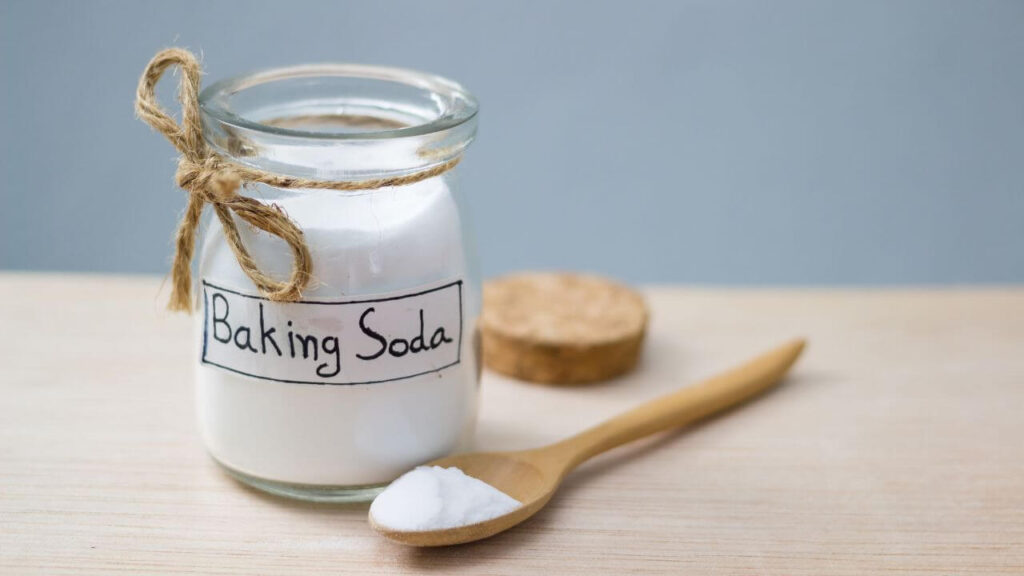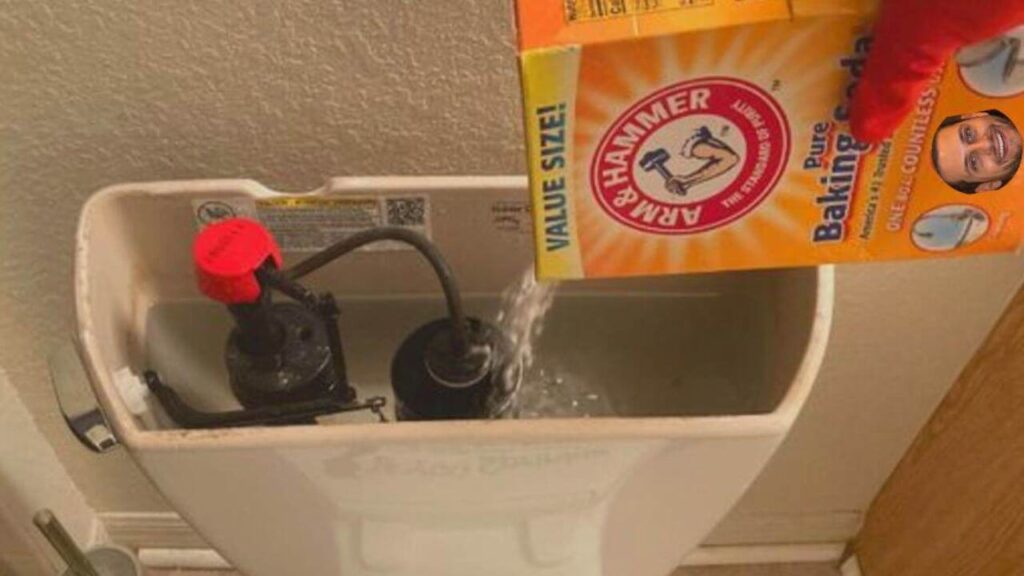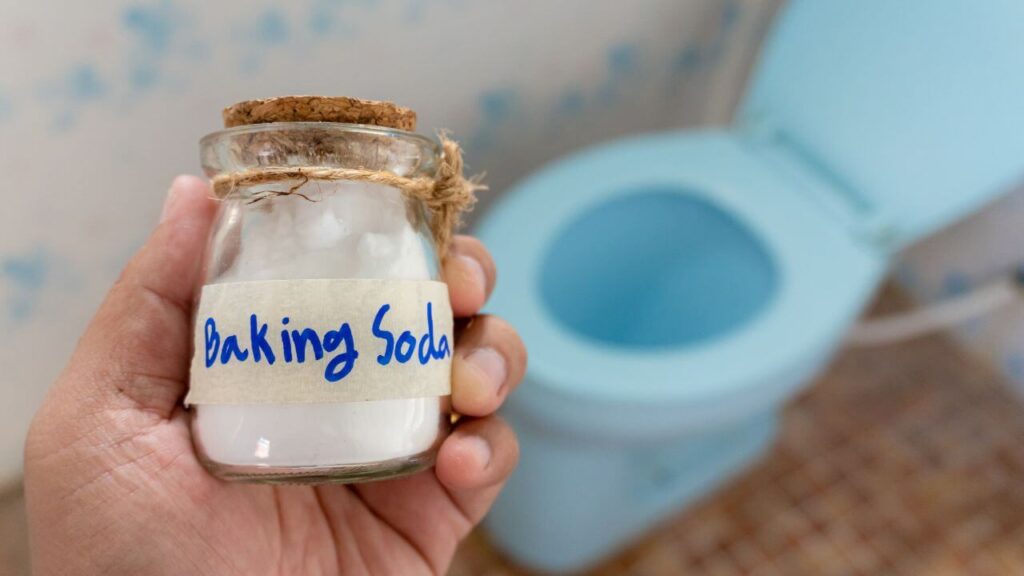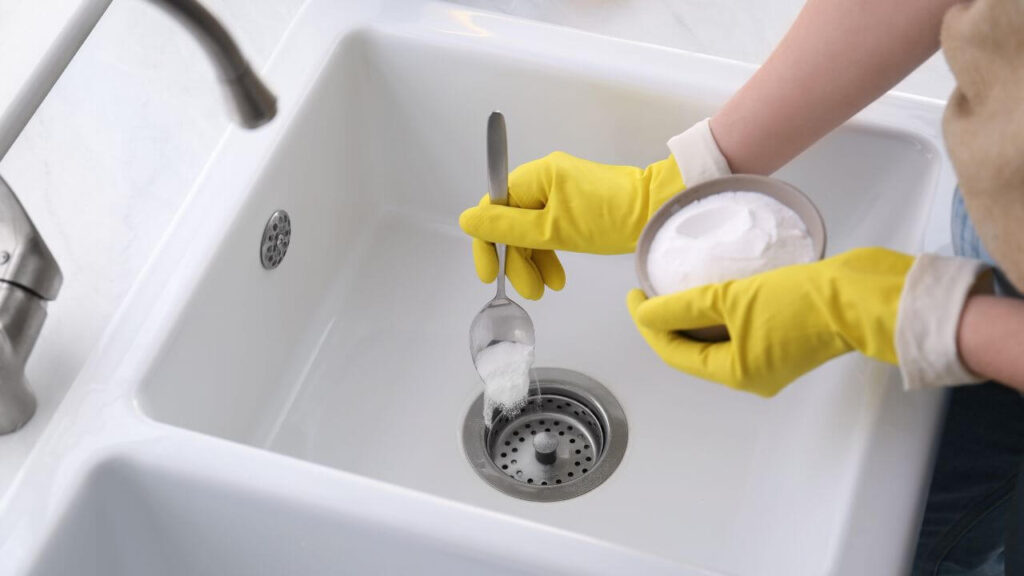Ah, let me share a little secret with you – the power of baking soda in the toilet tank. It might sound a tad unconventional, but trust me; it’s like a breath of fresh air for your bathroom!
Picture this: every time you flush, a hint of freshness fills the air, while baking soda quietly works its magic, tackling odors and keeping things cleaner.
It’s a simple yet oh-so-effective trick that I stumbled upon, and now I can’t imagine my bathroom without it.
Join me as we uncover the mystique behind this clever hack and elevate our bathroom game to a new level!
What Is Baking Soda And How Does It Work?

Baking soda, scientifically known as sodium bicarbonate, is a white crystalline powder. It’s a versatile compound used in cooking, cleaning, and more.
When baking soda interacts with acids, like vinegar or lemon juice, it reacts chemically, producing carbon dioxide gas. This gas forms bubbles, creating a fizzing effect.
In cleaning, the physical agitation from the fizz helps break down dirt and grime. In baking, the release of carbon dioxide causes the dough to rise.
Baking soda’s neutralizing properties also make it effective for odors. Its chemical versatility and reactivity make it an essential household item for various purposes.
Also Read:
Lysol Toilet Bowl Cleaner Turns Purple | Shades of Surprise
Can You Put A Bar Of Soap In Toilet Tank?
Can I Leave Bleach In The Toilet Overnight
Why Use Baking Soda In The Toilet Tank?

Using baking soda in the toilet tank might seem unconventional, but it can offer several benefits for maintaining a cleaner and fresher bathroom environment. Here’s why and how it works:
- Odor control
- Mild cleaning
- Reduced Mineral deposits
1. Odor Control
Bathrooms often harbor unpleasant odors due to waste, moisture, and lack of ventilation. Baking soda, known for its natural odor-neutralizing properties, can be placed in the toilet tank as an effective solution.
When baking soda interacts with odorous molecules in the air, it helps neutralize them, reducing or eliminating foul smells.
This introduces a more pleasant and fresher scent to the bathroom environment. As a passive odor absorber, baking soda creates a more comfortable and inviting space.
2. Mild Cleaning
Baking soda’s mild abrasive nature makes it a gentle yet effective cleaning agent. Placing baking soda in the toilet tank allows a small amount to dissolve in the tank water with each flush.
As this water is released into the toilet bowl, the dissolved baking soda creates a slightly abrasive solution.
This solution can help loosen and break down light stains, residue, and particles on the toilet bowl’s surface.
With regular flushing and the continuous introduction of baking soda-enriched water, the toilet bowl receives periodic mild scrubbing, helping to maintain its cleanliness and shine.
3. Reduced Mineral Deposits
Hard water, rich in minerals like calcium and magnesium, can lead to the formation of mineral deposits in the toilet tank and bowl.
These deposits appear as white or brownish stains and can be challenging to remove.
Baking soda’s unique ability to react with minerals in the water can help mitigate the impact of hard water.
Introducing baking soda into the toilet tank interacts with some of the minerals in the water, contributing to their precipitation and preventing them from depositing as readily.
While baking soda’s effect may be subtle, over time, it can help reduce the buildup of mineral deposits, potentially extending the period between more intensive cleanings.
Also Read:
Is Toilet Tank Water Clean | Know Experts Opinions
Can You Retrieve Something Flushed Down Toilet
Why Does Flushing The Toilet Affect The Shower
How To Clean Your Toilet Tank With Baking Soda

Cleaning your toilet tank with baking soda is a simple and effective process that can help maintain a fresher and cleaner bathroom. Here’s a step-by-step guide:
Materials Needed
- Baking soda
- Scrub brush or toilet brush
- Clean cloth or sponge
- Rubber gloves (optional)
- Distilled white vinegar (optional)
Step 1: Preparation
- Putting on rubber gloves is optional but can help protect your hands from any potential cleaning agents and bacteria in the toilet tank.
- Removing the toilet tank lid carefully prevents any accidental damage or breakage. Place the lid on a clean and safe surface to avoid any risk of contamination.
Step 2: Empty the Tank
- Flushing the toilet removes most of the water from the tank, making cleaning easier.
- Soaking up any remaining water with a sponge or cloth reduces the mess and allows better access to the interior surfaces.
Step 3: Apply Baking Soda
- Sprinkle baking soda evenly around the interior of the toilet tank, targeting areas with stains, mineral deposits, or buildup.
- Baking soda is a gentle abrasive that aids in loosening dirt and grime.
Step 4: Scrubbing
- Using a scrub brush or toilet brush, gently scrub the surfaces inside the tank.
- Apply slight pressure to areas with visible stains or mineral deposits, allowing the baking soda to lift and break down the buildup.
Step 5: Let It Sit
- Allowing the baking soda to sit for 15-30 minutes allows it to react with the stains and odors, facilitating their removal.
- During this time, the baking soda works as a natural deodorizer and continues to assist in breaking down grime.
Step 6: Scrub Again (Optional)
- You can scrub again using the baking soda mixture for more stubborn stains or areas requiring extra attention.
- This additional scrubbing can further aid in removing tough buildup.
Step 7: Rinse with Water (Optional)
- Using a clean cloth or sponge to wipe down the surfaces with water ensures that the baking soda and loosened debris are thoroughly removed.
- Alternatively, flushing the toilet a few times helps rinse any remaining baking soda and residue.
Step 8: Replace Tank Lid
- Carefully place the toilet lid back onto the tank, ensuring it is properly aligned and securely positioned.
Step 9: Routine Maintenance
- Regularly repeating this cleaning process every few weeks or as needed helps prevent the buildup of stains and odors in the toilet tank.
Optional Step: Vinegar Rinse
- After scrubbing with baking soda, adding a small amount of distilled white vinegar enhances the cleaning effect.
- The vinegar reacts with the baking soda residue, helping to dissolve it and remove any remaining buildup.
- Flushing the toilet a few times afterward, rinsing the vinegar and baking soda mixture.
Throughout the process, it’s important to be cautious and gentle with the scrubbing to avoid damaging any components inside the toilet tank.
Always follow safety precautions, and if you encounter any persistent issues or challenging stains, consider seeking advice from a plumbing professional.
Also Read:
How To Use Muriatic Acid To Clean Toilet | Get Rid Of Stains
What Do Hotels Use To Clean Toilets
Can I Flush Bleach Down The Toilet | Decoding The Mystery
How Often Can You Clean Your Toilet With Baking Soda?
You can clean your toilet with baking soda as often as needed, but a general guideline is to do it every few weeks or once a month.
Baking soda is a gentle cleaner, so frequent use is unlikely to harm your toilet.
However, excessive use may not be necessary and could lead to a buildup of baking soda residue. Adjust the frequency based on how quickly stains, odors, or mineral deposits reappear in your toilet tank and bowl.
Regular cleaning routines and proper flushing and ventilation can help maintain a fresh and hygienic bathroom environment.
Also Read:
How To Sanitize After Toilet Overflows
How To Use Liquid Fire In Toilet | 3 Simple Steps
Why Is My Toilet Gurgling On A Septic System | Gurgling Woes
Other Uses For Baking Soda In Your Bathroom

Baking soda is a versatile household item used for various purposes in your bathroom. Here are some other useful applications:
- Surface cleaning
- Shower and tub cleaner
- Grout cleaner
- Drain deodorizer
- Toothbrush cleaner
- Air freshener
- Showerhead cleaner
- Toilet bowl cleaner
- Mildew prevention
1. Surface Cleaning
Baking soda’s gentle abrasive nature makes it an effective cleaner for bathroom surfaces.
Sprinkle a small amount of baking soda on a damp cloth or sponge and gently scrub sinks, countertops, and tiles.
It helps remove stains, soap scum, and dirt without causing scratches.
2. Shower and Tub Cleaner
Create a paste by mixing baking soda with a small amount of water. Apply the paste to the surfaces of your shower and bathtub.
Let it sit for a few minutes to loosen grime and soap scum. Scrub with a sponge or brush, then rinse thoroughly for a sparkling clean result.
3. Grout Cleaner
Baking soda’s mild abrasive quality makes it effective for cleaning grout lines. Mix baking soda with water and apply a paste to the grout.
Scrub with a grout or old toothbrush to help lift dirt and stains. Rinse well after cleaning.
4. Drain Deodorizer
To keep the sink and shower drains smelling fresh, pour about half a cup of baking soda down the drain, followed by warm water.
The baking soda helps neutralize odors and can help prevent buildup in the pipes.
5. Toothbrush Cleaner
Soak toothbrushes in water and baking soda to help sanitize and remove residue. This can be particularly useful for keeping toothbrushes clean and fresh.
6. Air Freshener
Baking soda is a natural odor absorber. Place an open container of baking soda in your bathroom to help neutralize and absorb unpleasant odors, leaving the air fresher.
7. Showerhead Cleaner
Mineral deposits can clog your showerhead and affect water flow. Remove the showerhead and soak it in water and baking soda to help dissolve and remove these deposits.
8. Toilet Bowl Cleaner
Sprinkle baking soda inside the toilet bowl, especially targeting stains and mineral deposits. Let it sit for a while, then scrub it with a toilet brush and flush.
Baking soda helps break down grime and leaves the toilet looking cleaner.
9. Mildew Prevention
Baking soda can help prevent the growth of mildew in damp areas.
Apply baking soda to corners, grout lines, and other susceptible spots to help keep them dry and inhibit mildew growth.
Incorporating baking soda into your bathroom cleaning routine can provide a natural and effective way to maintain a clean and fresh environment.
Always rinse surfaces well after baking soda, and avoid using it on delicate or easily scratched materials.
Also Read:
Toilet Tank Too Close To Wall | How To Fix This Issue
How Should The Inside Of A Toilet Tank Look
How To Flush Toilet From Tank – Simplest Trick To Do It
Bottom Line
Putting baking soda in the toilet tank can help keep it fresher and cleaner by reducing odors and mildew.
However, use sparingly to avoid potential issues, and regular cleaning practices are still essential for maintaining a hygienic bathroom environment.
